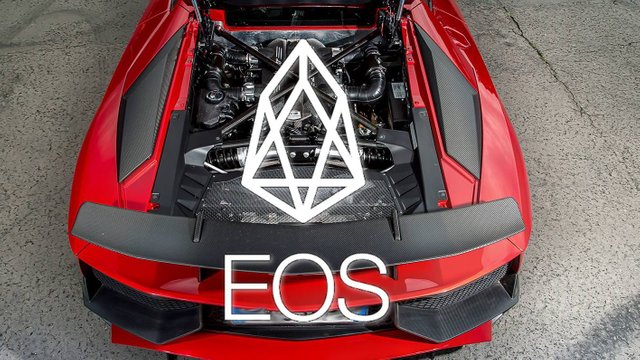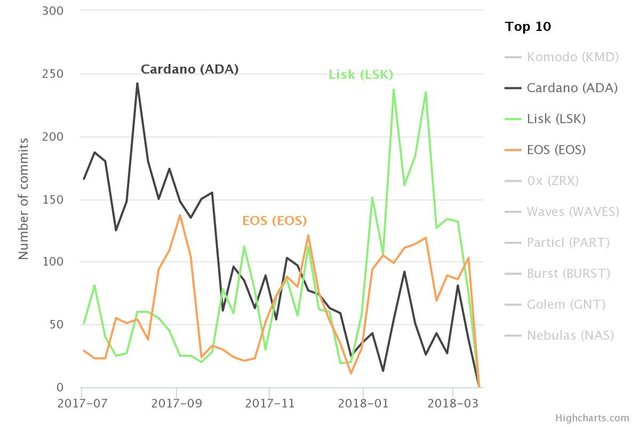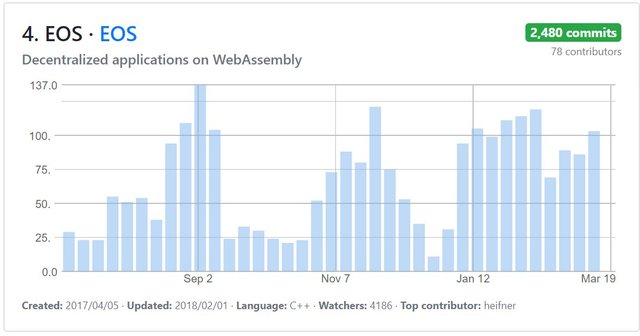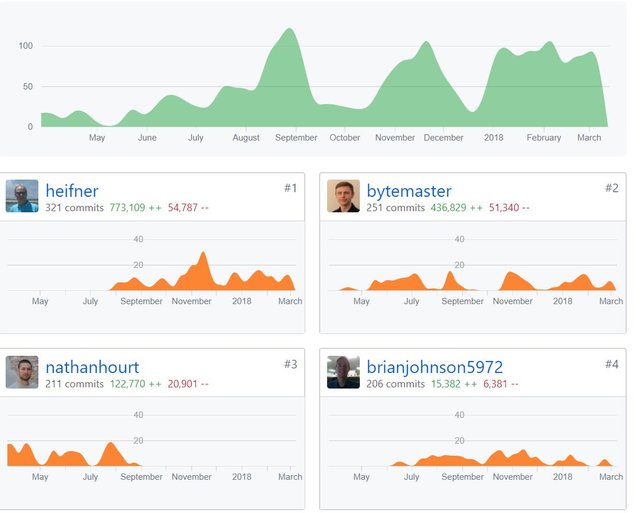EOS - Peeking under the hood - Part 3: Is the EOS dev infrastructure solid?
This is the third part of a series to critically asses the EOS project. If you havent read them, here are the first two articles:
Part 1 - Yet another ico?
Part 2 - How is the EOS blockchain established?
To summarize, the (main) EOS blockchain will be launched by the community, more precisely by 21 block producers, rather than block.one (the company behind EOS) themselves. What block.one are providing is the technological framework for the launch. (For further reading check out Part 2 of this series.)
So for EOS to succeed, the solidity of the code and the technical infrastructure is really key, as it will need to be ready to be used and adapted by 3rd parties from the beginning. That's what i'd like to take a closer look at in this part of the series:
Is the EOS development infrastructure solid?
Overview
The main technical aspect for developing on EOS is, that it is done in C++. This is quite uncommon in the crypto sphere, but it provides some striking padvantages, not the least widely available code repositories that can be used.
For further details, @ivanli provides a perfect introduction in programming concepts for eos (comparing them to ethereum). He also explains that the benefit of the choice for C++ is that it leads to more stable long-term focused code. But see for yourself: https://steemit.com/eos/@ivanli/programming-on-eos-vs-eth-programmer-explains
The EOS Software is currently available as alpha version, providing the necessary infrastructure for most development tasks. As of writing there is a fork between the code base (Dawn 3.0) for the development of dapps and the test-network (Dawn 2.0) where you can run test-nodes etc. A test-network for the new codebase is announced by end of Q1, so if everything runs according to plans this could be any day now (until now the project has been ahead of schedule). They also provide the libraries to run a private test-network, for performane testing, and claim they managed to reach several thousand transactions per second on average hardware.
Here are the official announcements, if you've missed them: https://eos.io/resources/#eos-dawn

Github Analysis
As being open source, the whole project is hosted on Github. To analyse a crypto technology, aside general aspects like concept, ideas, and the team, it's essential to always check out the code, because that's where the real action is going on.
I've followed the approach of fellow-steemer @eroche, who has carried out a few excellent analyses of similar projects. For our purpose, Cardano might be an example of particular interest:
https://steemit.com/beyondbitcoin/@eroche/cardano-github-activity-finding-patterns-in-the-noise
So i had a look at https://www.cryptomiso.com/ and what striked me most,is that EOS the No.4 among the top 10 most active crpyto projects on github. (Really interesting fact is that Cardano disappears from the top 10, when you limit the search to Q1/2018, up to March 20). I've looked at the past 9 months, since when EOS development has effectively launched.
Here is the comparison of the most commits per project:

In total there are 2480 commits in the past 9 months(Compare that to Ethereum, which has only a rough 600)

There are around 80 coders active over that period, and another pleasant surprise, Dan Larimer (aka Bytemaster) is among the top active developersSo it's evident, that he not only makes bold promises but is also working really hard on the project personally:

So as we really see, there is tremendous and thus really promising activity on github!But what is the outcome of it. The question is: are all of this thousands of lines of code usable at all?
Community Pick-Up
Although i have a technical background, i am not a programmer, so unfortunately i am not able to try out the framework myself. So i was delighted to find a bundle of online resources how the test-net can already be used:
@EOSphere, a block producer candidate, has produced a video along with an article how they set up the genesis-snapshot-generator (this is how the EOS blockchain will be established):
https://steemit.com/eos/@eosphere/how-to-setup-and-run-the-eosio-genesis-snapshot-generator
Then @rival has establish an EOS node using the test network:
https://steemit.com/utopian-io/@rival/eos-blog-building-my-eos-node-2-x-on-public-testnet
Smart contract development is covered as well, for one @ivanly (again!) has provided a simple smart-contract demo in one of his videos:
https://steemit.com/eos/@ivanli/eos-contract-programming-programmer-explains
If you are for a bit more in-depth discussion, @jd3 has done a similar thing but with a bit more detail information.
https://steemit.com/eos/@jd3/eos-introduction-to-programming-writing-smart-contracts
To summarize the core features are already accessible and usable on the testnet, and the bloggers above have put up good demonstration on how they are actually used successfully.
Those blogs are really convincing, and are a good confirmation that EOS.io is able to deliver on the promises.
Further DEV Ressources
To round things up, there are a few further online resources valuable for insights into the development environment.
First of all the EOS Developers Telegram Channel: https://t.me/joinchat/EaEnSUPktgfoI-XPfMYtcQ
It has impressive 4k participants and is a very lively community, and here again, Dan, the man, is a regular participant, sharing news and insights. This again proves the down to earth attitude of the EOS mastermind, which i believe is really a huge enrichment.
The @EOSGo (the org aiming to represent the EOS community) Forum has development section, but there's a bit less activity to be found there - https://forums.eosgo.io/categories/developers
Conclusion
The EOS Dev resources are definitely reassuring, und demonstrate well the solidity of the project, it is one of the most active crpyto projects on github, with 80 developers working on the framework. And the framework has already been successfully tested by several independent developers.
Is there anything that still could keep this project from flying?
Well, all this is in an Alpha stage, even if things look very good at this point, there is no guarantee the project will not fail eventually, maybe just because there is a hole in the concept as such?
But as you likely now, EOS will (re-) use a lot from concepts, that have been already proven highly successful in production, you know where i am heading: Steem, the very platform we are using, and i will check out the ups and downs of it in the next part IV of this series.
The information provided here sums up the results of my own - finite - research. If you've found this piece interesting or useful, please up-vote or resteem and help spread the word. If you have spotted anything inaccurate, or if you have any addition, or interpret things differently, please throw in your thoughts and comments! I am always happy to discuss and learn!
EOS - Peeking under the hood - Series:
Part 1 - Yet another ico?
Part 2 - How is the EOS blockchain established?
Part 3 - Is the EOS dev infrastructure solid? <-- YOU ARE HERE
Part 4 - Steem, lessons learned from this proof of concept? - Available soon
Part 5 - A platform constitution, how does that work? - Available soon

I love EOS, i love DAN's work.
Just curious:
Do you think STEEM and EOS will compete for the blockchain social-media sphere?
D.
I am certain that they will! Dan himself said, he intends to bild up a competitor. Something like Social Media 2.0 was dropped, if i recall correctly... Anyhow, competition is good for business isn't it?
He said "steem 2.0"
Exactly!
Another great post. Thanks for sharing. This is going to be one hell of a year for EOS.
It is really amazing! The closer i look into it, the more convinced i get....!
Excellent overview on the state of development for EOS. Resteemed.
If you've liked this article, please make sure to check the other ones too. Here is the summary with links to everything else:
https://steemit.com/eos/@conceptskip/eos-peeking-under-the-hood-finale-ready-for-the-dawn-of-blockhain
Thanks!

Nice
Thanks for the post! Once i understand enough, i hope to develop projects on eos platform myself. EOS looks big. Invest in this stuff with smart contracts and solid platform/team, not that gross bitcoin stuff.
Yes, developing as well as investing might be worthwhile! The ressources and infos are out there, good luck and looking forward to see more of your projects.
Looking forward for the next part: “Steem, lessons learned from this proof of concept?” For a non-programmer It is always easier to grasp a concept comparing it to something known.
Absolutely! It also shows if a person or team is able to deliver, and ideally we can learn from the dynamics of the concept. I need to answer a few questions, so slightly behind schedule smile
I've posted the article, looking forward to your feedback! https://busy.org/@conceptskip/eos-peeking-under-the-hood-part-4-lessons-learned-from-steem
My question is, what does that mean for hard-working users on steemit? Whales, even? If it's not a collaboration with steem, then it's a competitor, which means steem price will drop, which means for fiscal reasons, many users will jump ship over to EOS. Which means, anyone worth their salt will need to start over. Which sucks. Think he's got another plan to help the segue? Or maybe @ned will take him back. And they'll become allies at least.....
Really, I think all people want is better curation on a more natural scale. @dan is intending on remedying the abuse from spam and self-votes and bought votes.
I assume, you are referring to the steem 2.0, if yes then my answer would be it's definitely going to be a competitor, because that's what Dan has announced already. I can imagine it's going to be a tough competitor, but competition is good for business isn't it? I am going to publish my next article which will deal with steem today, and I'd really appreciate your feedback on it...
excellent article!